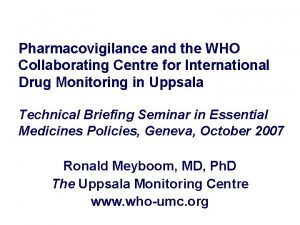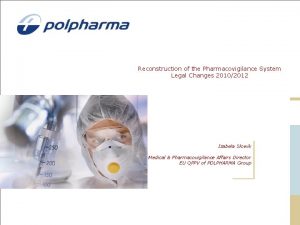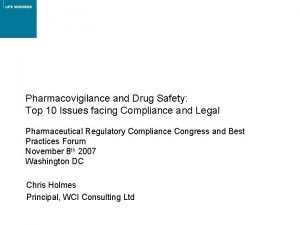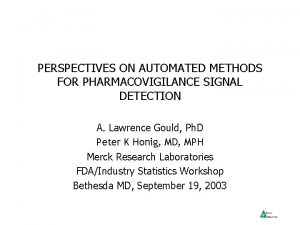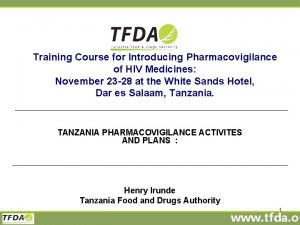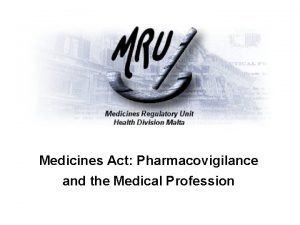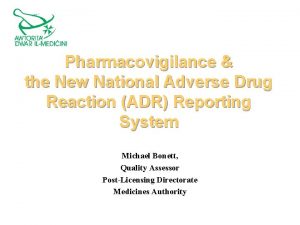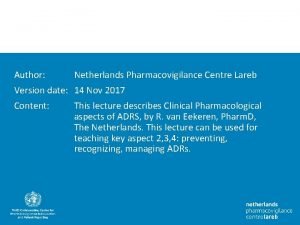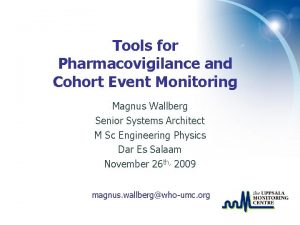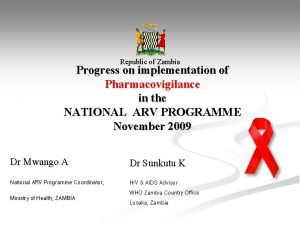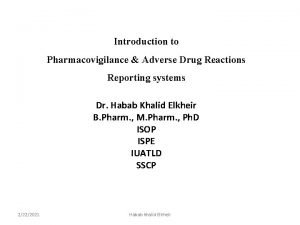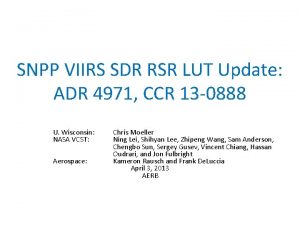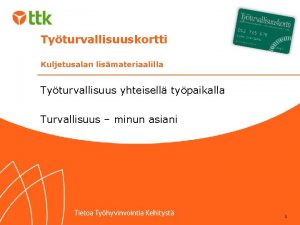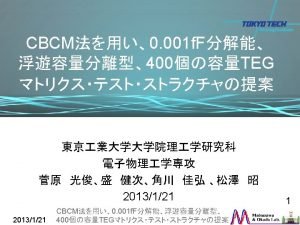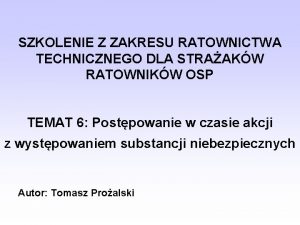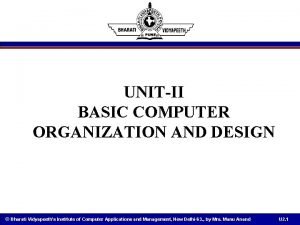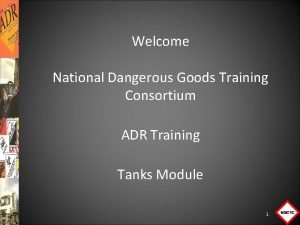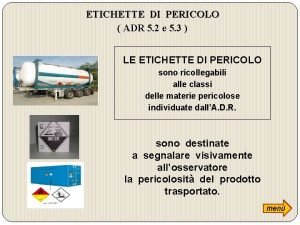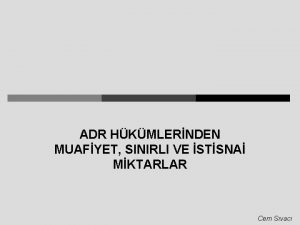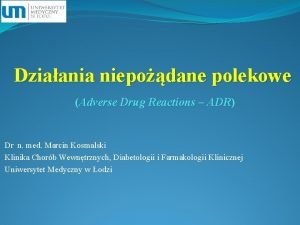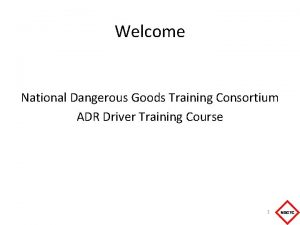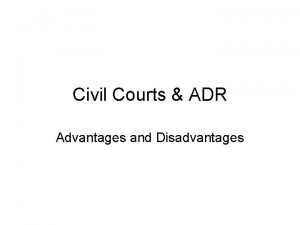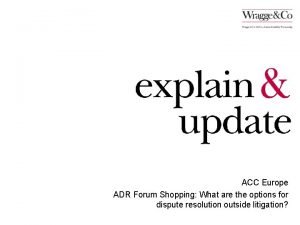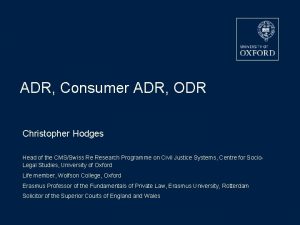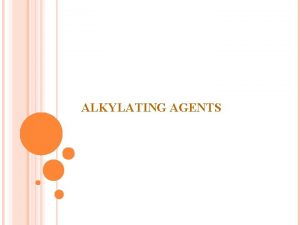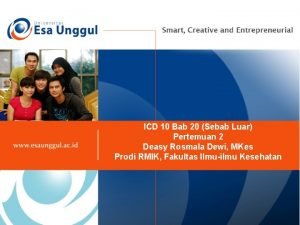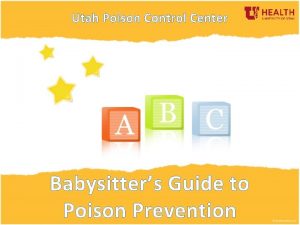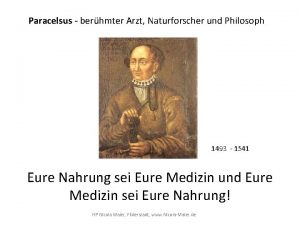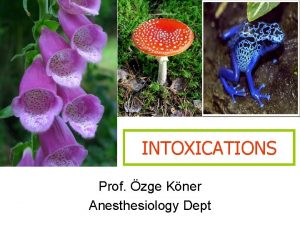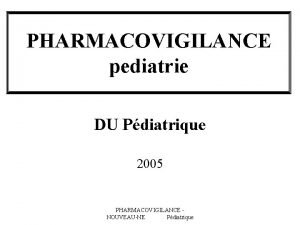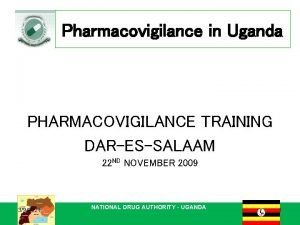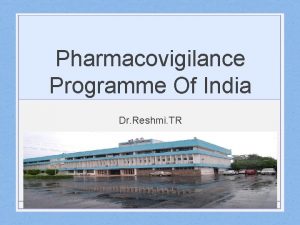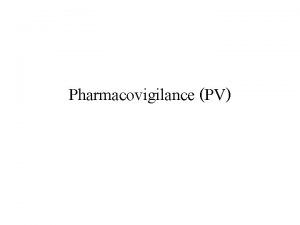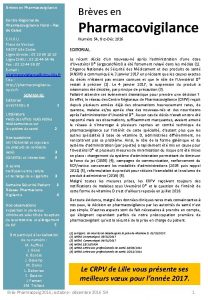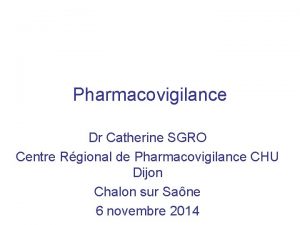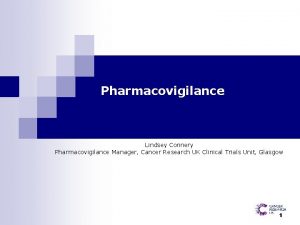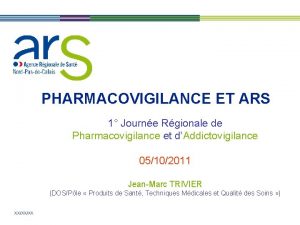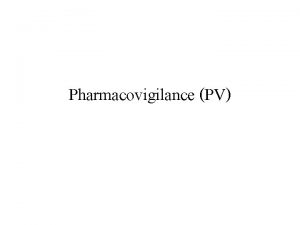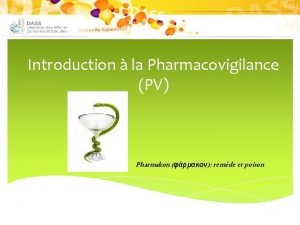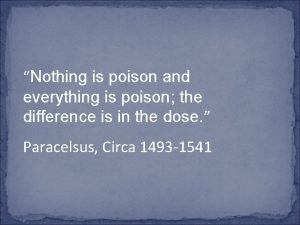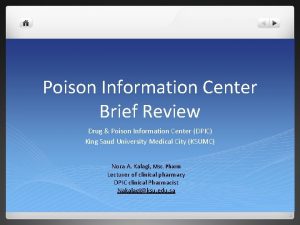ADR pharmacovigilance Philippus Aureolus Paracelsus 1493 1541 Poison


























































- Slides: 58

ADR, pharmacovigilance

Philippus Aureolus Paracelsus 1493 - 1541 „Poison is in everything, and no thing is without poison. The dosage makes it either a poison or a remedy. “

Each pharmacotherapy means risk akceptation, each drug can have potential risk for patient y p a er r a h p benefit Risk of pharmacotherapy should never exceed risks of not treating particular disease!!! th o c ma risk

Pharmacovigilance We take into consideration during drug selection: EFFICACY SAFETY PRICE SUITABILITY pharmakon (Greek for drug) vigilare (Latin for to keep watch)

Pharmacovigilance Includes all aspects of postmarketing development: - monitoring of clinical safety - identification of new threats - estimation of risk and contribution - action and communication Goal: to prove product safety after registration of the drug

Pharmacovigilance the science and activities relating to the detection, assessment, understanding and prevention of adverse effects or any other drug -related problem WHO established its Programme for International Drug Monitoring in response to the thalidomide disaster (1961) center for spontanneous ADR monitoring in Uppsala (Sweden)

In European Union spontaneous reports of suspected ADRs are sent from national pharmacovigilance centers to the Uppsala Monitoring Centre where they are processed, evaluated and entered into the WHO International Database

THALIDOMID 1959 -1961: sedative, hypnotic drug for pregnant women (marketed in Germany, England, Canada. . . , never in USA) Born were > 12 000 children with phocomelia Now: new indications – imunomodulatory, antiangiogenic and antiinflammatory properties: skin lupus erythematodes skin form of lepra Kaposi´s sarcoma at AIDS. . .


ØADVERSE DRUG REACTION = ADR Reaction to drug which is noxious and unintended and occurs at doses of drugs normally used for prophylaxis, diagnosis or treatment of disease or to modify physiologic functions Detection of ADR at targeted monitoring 10 -30%. At spontanneous monitoring < than 1%. Intoxications and mistakes in therapy don´t belong here

ØADVERSE DRUG REACTION From the point of view of drug = ØADVERSE EFFECT From the point of view of patient

ØTOXIC EFFECT Not common at normal doses ØSIDE EFFECT Is related to the pharmacological properties of drug, althought not the main aim of theray may be beneficial rather than harmful

Ø SIDE EFFECT Each unintend drug effect, occuring at normal doses used for patients, which is in relation to pharmacologic properties of drug. (beta-blockers as antihypertensives + relieving the symptoms of angina) Ø ADVERSE EVENT Each noxious health event, which can occur during therapy, but doesn´t have to have relation with this therapy. (patient takes ATB and breaks his leg)

Ø UNEXPECTED ADVERSE REACTION Adverse reaction whose character or intensity isn´t in concordance with domestic informations about drug or isn´t expected according to drug characteristic. Ø SIGNAL Reported information about possible causal relationship between adverse event and, this relationship was yet unknown or incompletely documented. Usually more than 1 report is required for signal.

Risk factors of ADR Drug Pacient nonselective and nonspecific polymorbidity with narrow therapeutics range diseases of organs of elimination lipophilic age, women pharmacokinetic variability (etnic group, genetic polymorphism) compliance Prescription wrong selection of drug, drug combination, dose, route of administration, therapy length Number of drugs 0 -5 6 -10 11 -15 > 16 ADR 4% 10% 28% 54%

Classification of ADRs according to mechanism of origin according to severity according to frequency

I. ADR according to mechanism of origin 1. Type A („Augmented“) Dose-related these ADR are expected they can be predicted on the base of pharmacodynamic properties of drug they depend on drug dose, they appear at higher doses frequency is high > than 1% mortality is low therapy consists in dose adjustment e. g. : cough after ACEI, bleeding from GIT after NSA, aspirin, corticoids. . .

2. Type B („Bizzare“) Non-dose-related immunologic and idiosyncratic reactions these ADR are not expected they can be hardly predicted doesn´t depend on dose frequency is low < than 0, 1% mortality is high treatment consists in stopping drug administration e. g. : haemolytic anaemia after metyldopa, hepatitis induced by isoniazid, allergic reaction after PNC. . .

rash

TYPE A TYPE B Predictability + – Dosage dependence Occurrence + – high low Mortality low high Treatment dose adjustment stopping administration

1 drug – different types of ADR DRUG Type A reaction Type B reaction Ampicillin Pseudomembr. colitis Intersticial nephritis, allergy Chlorpropamid Sedation Hepatotoxicity Naproxen GIT haemorrhage Agranulocytosis Warfarin Bleeding Breast necrosis

3. Type C („Continuous“) Dose-related and time-related this type of ADR increases number of “spontanneous“ diseases they occur usually after long-lasting administration they are often serious and persistant mechanism of genesis is unclear they are unexpected, not predictable they can´t be verified experimentally e. g. : oral contraceptives and increased occurrence of thromboembolia, analgetic nephropaty, . . .

4. Type D („Delayed“) Time-related late ADR (years resp. generations) teratogenity carcinogenity mutagenity Carcinogenity e. g. : ca. of vagina at daughters of mothers treated with dietylstilbestrol cytotoxic and immunosuppressant drugs

Some known teratogens Warfarin (saddle nose, retarded growth, defects of limbs, eyes and CNS) Phenytoin (cleft of lip and palate, microcephaly, mental retardation) Valproate (neural tube defects) Ethanol (fetal alcohol syndrome) ACEI (oligohydramnion, renal failure)

Fetal development and drugs 0 -16 days (blastocyst formation; cytotoxic drugs) 17 -60 days (organogenesis; teratogens) 60 -term (histogenesis and functional maturation; alcohol, nicotine, steroids, . . . )

5. Type E („End of Use“) End of use after therapy ending (syndrom from omitting) rebound phenomenon e. g. : beta blockers, opioids, corticosteroids, nitrates. . .

II. ADR according to intensity mild – don´t require to stop or to change treatment moderate – require to change therapy, but don´t threat life of the patient serious – death, hospitalization, invalidization, teratogenity

III. ADR according to frequency Frequency Very common (>10%) > 1/10 = (more than 1 in 10 people are affected) Common (frequent) (1 -10%) > 1/100 and < 1/10 Uncommon (infrequent) (0, 1 - 1 %) > 1/1000 and < 1/100 Rare (0, 001 -0, 1%) > 1/10000 and < 1/1000 Very rare (< 0, 001 %) < 1/10000

The most frequent drugs causing ADRs DIGOXIN ANTIBIOTICS, PNC DIURETICS POTASSIUM ANALGESICS NSAIDs, ASPIRIN SEDATIVES, PSYCHOPHARMACONS INSULIN GLUCOCORTICOIDS WARFARIN

1. Digoxin Digitalis glycoside Originally isolated from foxglove (Digitalis purpura) Binds to energy dependent Na+ pump Useful for treating certain arrhythmias ADRs: arrhytmogenic nausea, vomitting, anorexia Gynaecomastia TDM (extremely low dose)

2. Antibiotics PNC (allergy) Aminoglycosides (ototoxicity, nefrotoxicity) Tetracyclines (avoid in children and pregnant women)

3. Diuretics osmotic, loop, thiazide and thiazide related diuretics, potassium-sparing Indications: hypertension, heart failure, nephrotic syndrome, hepatic cirrhosis ADRs: hypokalaemia, hypotension, hypomagnesaemia, hyperuricaemia

4. Potassium ADRs: arrhythmias Drugs with potential to cause hypokalaemia: diuretics, corticosteroids, . . . Drugs with potential to cause hyperkalaemia: amilorid, spironolactone, ACEI, . . .

5. Analgesics (opiates, NSAIDs) frequent causes of ADRs NSAIDs (many of them OTC)

6. Sedatives, psychopharmacons many ADRs; many of them addictive

7. Insulin the most feared ADR: hyoglycaemia

8. Glucocorticoids locally at asthma: no systemic ADR systemic administration: avoid for longer time if not neccessary (adrenal and/or pituitary suppression); many systemic adverse effects

9. Warfarin the most feared ADR: bleeding need to monitor INR

Determination of causality Basic categories: A. High probability of causality B. No sufficient proof of causality 0. Isn´t possible to evaluate causality

Diagnosis and determination of causality is patient taking OTC, herbal or traditional remedies, recreational drugs, drugs of abuse, long-term treatments (e. g. oral contracetive) Timing • the time relation between the use of the drug and the reaction Pattern recognition • the pattern may fit the known pharmacology or allergy pattern of one of the suspected medicine • frequency of the event and how often it is associated with drug (headache – common even without taking drugs, aplastic anaemia – more likely to be ADR)

Diagnosis and determination of causality Investigations • Plasma concentration measurements, biopsies, allergy tests • Sometimes is needed to establish baseline functions at the start of therapy (e. g. amiodarone – thyroid function) • Dechallenge the stopping of the drug: Positive dechallenge: ADR disappearing after the stopping of the drug. A negative dechallenge: ADR not disappearing after the stopping of the drug. • Rechallenge restarting of the same drug after having stopped it, usually for an ADR. Can be possitive/negative

Diagnosis and determination of causality Investigations • Challenge is giving of the drug to the patient during the ADR or treatment in question. • Prechallenge is use of the same drug at some point in the past.

ACTIONS AT PROOF OF CAUSALITY warning methodic direction limitation of indication change of dose deregistration of the drug

Deregistered drugs Troglitazon (p. o. antidiabetic; drug-induced hepatotoxicity) Benaxoprofen (NSAIDs; liver and kidney failure, gastrointestinal bleeding, ulcers) Terfenadin (antihistamine; prolonged QT interval, ventricular tachycardia) Mibefradil (CCB; fatal arrhythmia, drug interactions) Cerivastatin – 2001 -2002 (risk of rhabdomyolysis) Rofekoxib, Vadekoxib – 2004 -2005 (risk of myocardial infarction and stroke) group with the highest risk NSAIDs (> 30% of deregistrations)

% of ADR reported at active monitoring: 10 -30% (mostly done by pharmaceutical companies during clinical trials) at pasive monitoring: < 1% Type A ADR: - 80% Treatment of ADR represents 13 -15% of therapy costs ADR occurs mostly between 1 -10 day from beginning of therapy

ADVANTAGES of pharmacovigilance at worldwide cooperation Large number of treated patients Detection of possible race variations Detection of rare ADR Possibility of soon warning of particular drug risk all over the world

Safety of drugs in children Off-label drug use remains an important public health issue, especially for infants, young children, and children with rare diseases Clinical trials in children (special considerations)

Safety of drugs in pregnancy Former pregnancy medication categories: Category A: Controlled studies show no risk or find no evidence of harm. Category B: Animal studies show no risks, but there are no controlled studies on pregnant women. Category C: Animal studies have shown risk to the fetus, there are no controlled studies in women, or studies in women and animals are not available. Category D: There is positive evidence of potential fetal risk, but the benefits from use in pregnant women may be acceptable despite the risk (i. e. life threatening condition to mother). Category X: Studies in animals or human beings have demonstrated fetal abnormalities, or there is evidence of fetal risk. The drug is contraindicated in women who are or may become pregnant. Category C (confusing category). A medication gets this classification if there is insufficient data on its use during pregnancy. It could be safe or probably safe, or it could be potentially harmful.

Safety of drugs in pregnancy In 2015 the FDA replaced the former pregnancy risk letter categories on prescription and biological drug labeling with new information to make them more meaningful to both patients and healthcare providers. While the new labeling improves the old format, it still does not provide a definitive “yes” or “no” answer in most cases.

Safety of drugs in pregnancy The A, B, C, D and X risk categories, in use since 1979, are now replaced with narrative sections and subsections to include: • • • Pregnancy (includes Labor and Delivery): Pregnancy Exposure Registry Risk Summary Clinical Considerations Data Lactation (includes Nursing Mothers) Risk Summary Clinical Considerations Data Females and Males of Reproductive Potential Pregnancy Testing Contraception Infertility

DRUG TOXICITY Pharmacological (predictable extension of the known pharmacology of drug) Biochemical (tissue damage or toxicity caused by interaction of the drug or its metabolite with cell components such as structural proteins or enzymes) Immunological (allergic reactions)

Pharmacological drug toxicity ADRs related to primary use e. g. warfarin (risk of ischaemia/bleeding) ADRs unrelated to primary use e. g. opioid analgesics (respiratory depression) the most frequent toxicities If needed to take drugs, might be prescribed drugs to reduce side effects (e. g. chemotherapeutics + antiemetics)

Biochemical drug toxicity Methaemoglobinaemia, haemolysis (e. g. primaquine) Hepatotoxicity (e. g. acetaminophen, isoniazid) Nephrotoxicity (e. g. cyclophosphamide) Cardiotoxicity (e. g. doxorubicin)

Immunological drug toxicity Types of allergic reactions: 1. Immediate/anaphylactic reactions (via Ig. E; minutes to hours after drug exposure; e. g. penicillins, peptide drugs) 2. Cytotoxic reactions (specific Ig. G or Ig. M antibodies directed at drug-hapten coated cells; variable timing; e. g. thrombocytopenia, neutropenia, haemolytic anaemia) 3. Immune-complex reactions (tissue deposition of drugantibody complexes with complement activation and inflammation; 1 -3 weeks after drug exposure; e. g. serum sickness, lupuserythematosus-like syndrome) 4. Cell-mediated/delayed reactions (major histocompatibility complex presentation of drug molecules to T-cells with the release of cytokines and inflammatory mediators; e. g. contact dermatitis)

Anaphylaxis a severe, potentially fatal allergic reaction allergic symptoms can affect several areas of the body and may threaten breathing and blood circulation (low blood pressure) food allergy is the most common cause of anaphylaxis (e. g. peanuts, tree nuts, milk, egg, soy, wheat, fish, shellfish); strict avoidance of problem foods other causes: insect stings, medications, latex epinephrine auto-injector (i. m. ) in known severe allergy should be carried and used if needed (it must be administered promptly to be most effective) epinephrine expires after a certain period (usually around one year) even if epinephrine is administered promptly and symptoms seem to subside completely, the individual who was treated with epinephrine should always be taken to the emergency room for further evaluation and treatment According to: Food Allergy and Research Education

Anaphylactic shock an episode of anaphylaxis where the person goes into a state of shock due to poor blood circulation that deprives the body of oxygen and nutrients shock does not happen with most cases of anaphylaxis stop administration (e. g. penicillin i. v. ) A, B, C, D, E (airway, breathing, circulation, disability, exposure) feet raised, give oxygen, establish venous acces, monitor BP

Anaphylactic shock epinephrine other medicaments administered: antihistaminic drug hydrocortisone i. v. if hypotension persists (i. v. fluids) if hypoxia (assisted ventilation) take blood for tryptase levels (diagnosis) According to: Kumar and Clark, 2017

 En 1493
En 1493 Theophrastus phillippus aureolus bombastus von hohenheim
Theophrastus phillippus aureolus bombastus von hohenheim Paracelsus einsiedeln
Paracelsus einsiedeln Paracelsus
Paracelsus Paracelsus her madde zehirdir
Paracelsus her madde zehirdir Bitka pri moháči
Bitka pri moháči Rozdelenie uhorska 1541
Rozdelenie uhorska 1541 International pharmacovigilance centre
International pharmacovigilance centre Jamasoft
Jamasoft Indegene pharmacovigilance
Indegene pharmacovigilance Solicited reports in pharmacovigilance
Solicited reports in pharmacovigilance Pvnet pharmacovigilance
Pvnet pharmacovigilance Pharmacovigilance signal detection methods
Pharmacovigilance signal detection methods Pharmacovigilance quality assurance
Pharmacovigilance quality assurance Kålbrok
Kålbrok Principles of pharmacovigilance
Principles of pharmacovigilance Cem stands for in pharmacovigilance
Cem stands for in pharmacovigilance Pharmacovigilance compliance
Pharmacovigilance compliance Mru medication authority
Mru medication authority What is pharmacovigilance
What is pharmacovigilance Netherlands pharmacovigilance centre lareb
Netherlands pharmacovigilance centre lareb Cohort event monitoring in pharmacovigilance
Cohort event monitoring in pharmacovigilance Application of pharmacovigilance in zambia
Application of pharmacovigilance in zambia Pharmacovigilance definition
Pharmacovigilance definition Fidlit
Fidlit Adr sdr
Adr sdr Toimittaja ei saa osallistua turvallisuusyhteistyöhön?
Toimittaja ei saa osallistua turvallisuusyhteistyöhön? Adr dangerous goods consortium
Adr dangerous goods consortium Podlimitná preprava adr
Podlimitná preprava adr Dr syed ali
Dr syed ali Task no.1 adr
Task no.1 adr Adr tabela
Adr tabela Adr turvaohjekortti
Adr turvaohjekortti Liczba czterocyfrowa w mianowniku tablicy adr
Liczba czterocyfrowa w mianowniku tablicy adr During _______ branching, only car is updated with adr
During _______ branching, only car is updated with adr Dangerous goods consortium
Dangerous goods consortium Pqrsta
Pqrsta Reaction turbine animation
Reaction turbine animation Etichette pericolo adr
Etichette pericolo adr Adr írásbeli utasítás 2021
Adr írásbeli utasítás 2021 Sınırlı miktar işareti
Sınırlı miktar işareti Adr adverse drug reaction
Adr adverse drug reaction Adunek
Adunek Adr poäng
Adr poäng Adr consortium
Adr consortium Advantages and disadvantages of being a lawyer
Advantages and disadvantages of being a lawyer What are the options
What are the options Adr
Adr Adr of alkylating agents
Adr of alkylating agents Yxyzx
Yxyzx Exotoksin
Exotoksin What term does the chorus use to describe the lovers?
What term does the chorus use to describe the lovers? Keracunan makanan icd 10
Keracunan makanan icd 10 Did paris love juliet give evidence to support your answer
Did paris love juliet give evidence to support your answer Othello and jealousy
Othello and jealousy Latin for poison
Latin for poison Poison control.aspx?gameserver=
Poison control.aspx?gameserver= Utah poison control center
Utah poison control center Are platypuses poisonous
Are platypuses poisonous
